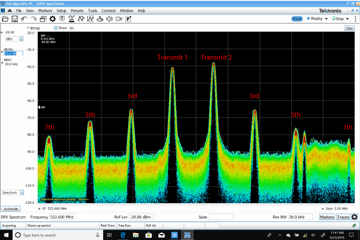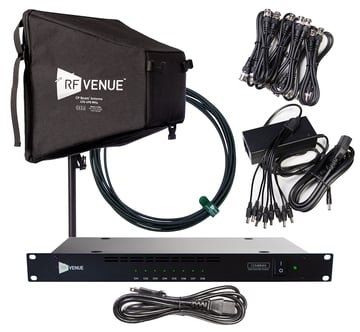
We are frequently asked for help designing wireless systems that use both wireless mics and wireless IEMs working together. So here's a basic strategy for how best to construct that system.
Background
It’s a simple fact that more wireless devices in the same space makes it more difficult to maintain reliable performance. More devices require finding more empty space in which to operate. And in this era of shrinking spectrum, empty space is at a premium and demand for wireless keeps climbing. In addition, every time you turn on another transmitter you increase the amount of intermod in your workspace. So you don’t have to do the math, 4 transmitters gets you potentially 24 IM products, 8 transmitters gets you north of 40K products and 16 get you beyond 20 trillion possibilities! It's a complex dance involving transmitter output power and relative distances between them. In practice, this typically just adds up to a rise in the noise floor. Another consideration is that for every 1dB increase in the power of your transmitter, the 3rd order IM increases by 3dB. That is a major reason when operating multiple transmitters to always use the minimum power necessary.
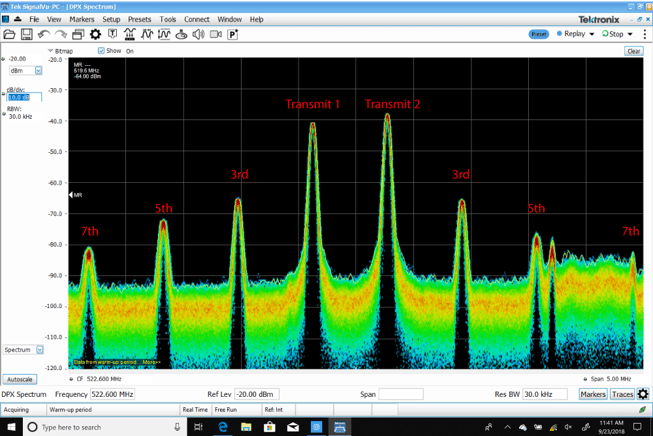
IMD products generated from two transmitters in proximity
Spacing Mics and IEMs
The general rule of thumb has always been that channels should be assigned a frequency at least 250 KHz away from any strong 3rd order harmonic. The more space, the better. Thankfully with the rise of software coordination programs, you no longer need to do the heavy lifting of calculating the intermod frequencies yourself. We highly recommend that you take advantage of these programs any time you are using multiple wireless systems. [If you missed it, our series on spectrum analysis for wireless audio is here]
The basic element of the strategy for spacing wireless mics and IEMs is to operate your mics at one end of the band and your IEMs at the other end. A good practice is to separate the mics at one end and the ears in the other. Without getting overly complicated here, a best practice is to group your mics together and group your ears together as tightly as possible with a gap between them of at least 4 MHz, but ideally much more. Based on the most common blocks for wireless mics in the USA, make certain ALL of your mics can tune below 558 MHz and ALL of your ears can tune above 564MHz although other split points can be used to match specific equipment. The exact frequencies you tune to will of course be determined by the local conditions at your venue and the total number of frequencies required. You could also flip this and set your ears to the low end of the band and your mics to the high end.
You will be best served to not tune any ears between mic frequencies nor mics between ear frequencies. If you are dealing with gear you already own and have no other choice you are not necessarily out of luck. But maintaining reliable dropout free performance will likely be more difficult. Make sure you allow at least 4MHz between your mics end and ears end.
Bandpass filtering IEM transmitters from mic receivers
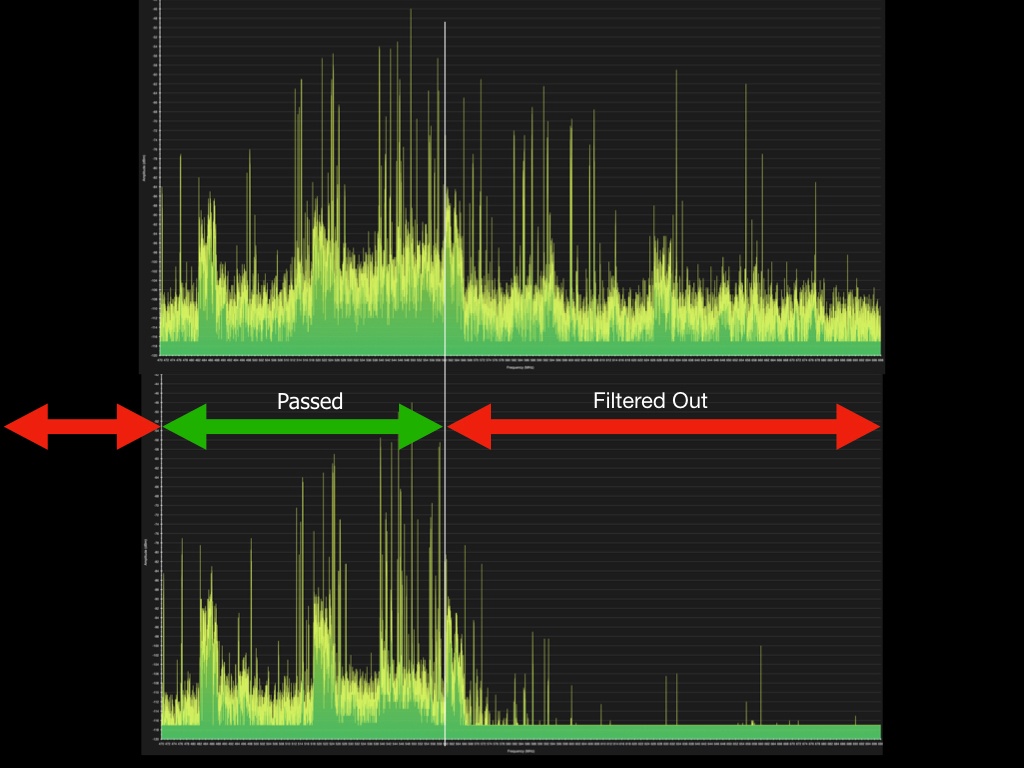
To further decouple the effect that the IEM transmitters place on the wireless mic receivers we simply add the appropriate pair of bandpass filters at the A & B antennas and connect into the antenna distribution system. These filters allow the frequencies inside the bandpass to pass through unaffected but block RF from outside the bandpass (namely the signals from the IEMs) from ever getting into the wireless mic receivers. The result is that as far as the wireless mic receivers are concerned, the IEMs don’t exist as they will be knocked down by about 40dB.
Why don’t we add BPFs to the IEMs you might ask? Well these bandpass filters block RF from entering receivers. So you would have to add a BPF to each and every IEM beltpack. Most performers would be greatly annoyed by the extra bulk not to mention the expense! Because the transmit power from wireless mics is typically much lower than that from IEMs your ears are not nearly as negatively affected by the mics as the mics are by your ears.
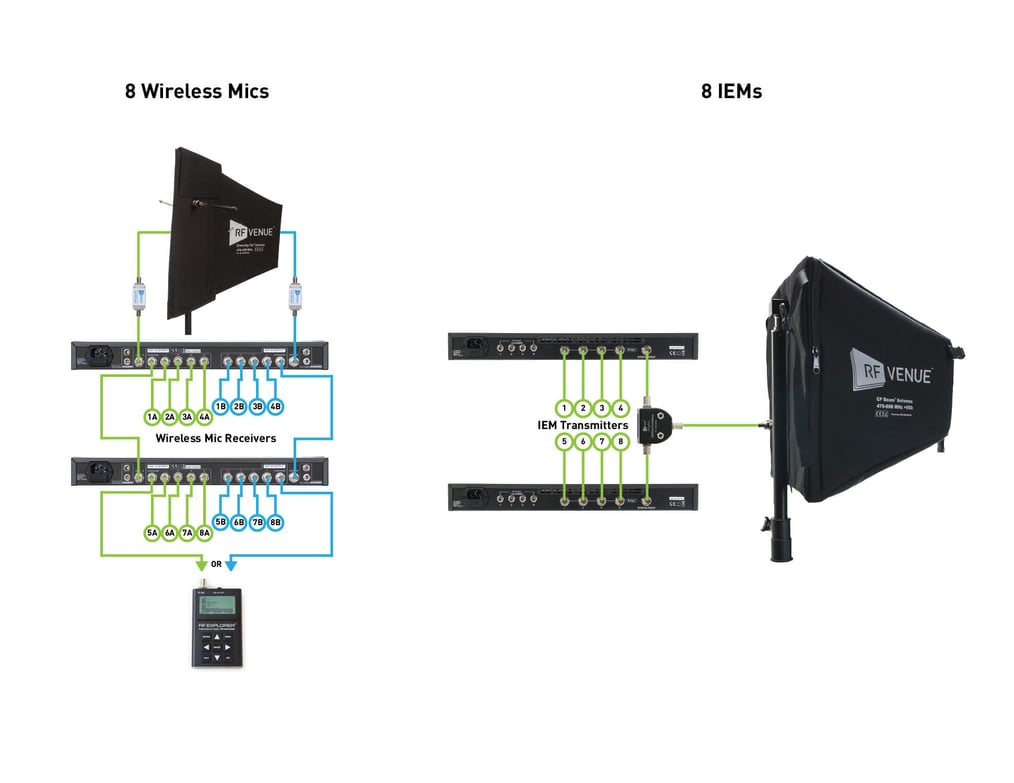
Note that when using a pair of Distro4s you can use any spare output to connect to your spectrum analyzer to get an exact sense of whether IEM frequencies or IMD products are impacting your receivers. If you encounter this on your scans, then the next step is a thorough War Gaming exercise to root out the frequency (or multiple frequencies) causing the ingress to the mic system. Frequency coordination software tools are powerful, but they are no match for on the ground visual spot-checking for noise entering your mic receivers.
By all means, this basic strategy presented here can be modified to be used with any different combination of wireless mics and IEM/IFBs. And there are certainly more advanced techniques for larger scale projects. Just remember to maintain a guard band of at least 4MHz in the middle for good performance. And don't forget to position transmitting and receiving antennas a minimum of 4' apart (further is better).
For additional information please see Part 2 of this article
And we've got even more details to dig into in our free ebook at the link below:
Don Boomer
Don Boomer is Senior applications engineer at RF Venue. He has worked in R&D in the past for Peavey, Sabine and Line 6 and his rock band from his high school days has a song in the Rock n Roll Hall of Fame
More from the blog
Subscribe to email updates
Stay up-to-date on what's happening at this blog and get additional content about the benefits of subscribing.


